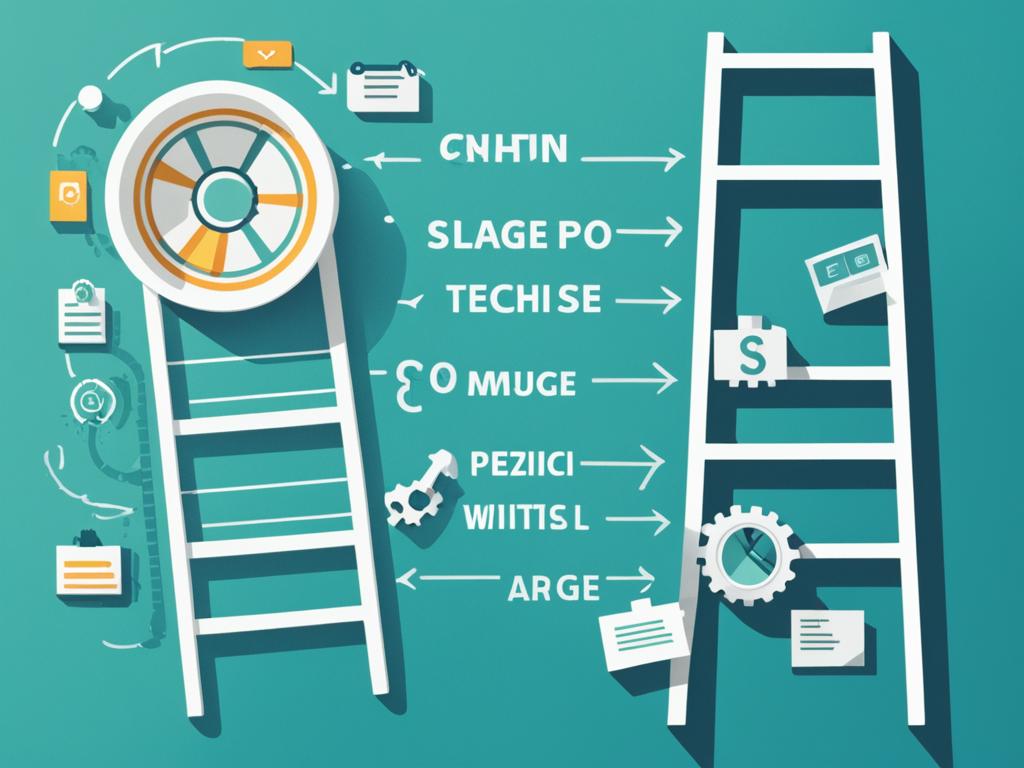Are you struggling to improve your website’s visibility and search engine rankings? Do you want to know the secret to optimizing your webpages for higher rankings? Look no further! In this article, I will share with you the most effective on-page SEO techniques and valuable tips that will catapult your website to the top of the search results pages.
When it comes to SEO optimization, on-page SEO plays a crucial role in improving your website visibility and attracting organic traffic. By implementing the right search engine optimization techniques, you can ensure that your website is easily crawled and indexed by search engines like Google.
But what are the best practices for on-page SEO? What are the key factors that Google considers in its search ranking algorithm? How can you optimize your website for both search engines and human readers? Get ready to uncover the answers as we dive deep into the world of on-page SEO.
Key Takeaways:
- On-page SEO is vital for improving website visibility and search engine rankings.
- Implementing on-page SEO techniques helps search engines understand your website’s value.
- Optimizing various elements on your webpages, such as content and HTML, is crucial for better rankings.
- Keyword research and incorporating keywords naturally into your content are essential on-page SEO practices.
- By following an on-page SEO checklist, you can ensure that all important elements are optimized effectively.
What is On-Page SEO?
On-page SEO, also known as on-site SEO, involves optimizing the various front-end and back-end components of your website to improve its visibility and rankings on search engine results pages. It encompasses the optimization of content, site architecture, and HTML elements to ensure that your website is easily crawled and indexed by search engines. On-page SEO is a critical factor in achieving higher search engine rankings and attracting organic traffic.
Google’s algorithm, along with other search engines, considers on-page SEO as one of the key ranking factors. By optimizing your website’s on-page elements, you stand a better chance of ranking higher and driving more targeted traffic to your site.

When it comes to on-page SEO, there are two main components: front-end and back-end.
- The front-end component refers to elements that are visible and accessible to website visitors. It includes content, headings, images, and user experience-related factors.
- The back-end component, on the other hand, consists of technical aspects that are not visible to website visitors but play a crucial role in optimizing your website for search engines. This includes HTML markup, meta tags, structured data, and website performance.
To achieve effective on-page SEO, it’s important to understand Google’s algorithm and its search engine ranking factors. Google takes into consideration various aspects of on-page SEO when determining a website’s search ranking. These factors include:
„Google’s algorithm analyzes on-page SEO elements to determine the relevancy, quality, and crawlability of a website. By optimizing these elements according to best practices, you can improve your website’s chances of ranking higher.“
Front-End Components
- High-quality and relevant content that aligns with search intent
- Properly optimized page titles and headings
- Clear and concise meta descriptions that entice users to click
- Optimized image alt-text for better accessibility and search engine understanding
- Structured markup to provide additional information to search engines
Back-End Components
- Optimized page URLs for better crawlability and user experience
- Strategically placed internal links to improve website navigation and accessibility
- Mobile responsiveness for seamless user experience across devices
- Fast site speed for improved user satisfaction and search engine crawling
By optimizing both front-end and back-end components, you can enhance your website’s on-page SEO and increase its chances of ranking higher in search engine results pages.
Why is On-Page SEO Important?
On-page SEO plays a vital role in website optimization for Google and other search engines. It allows them to understand the value your website provides to visitors and customers. By implementing on-page SEO best practices, you make it easier for search engines to crawl and index your pages, improving your website’s visibility and rankings.
But on-page SEO is not just about optimizing for search engines. It also focuses on making human-readable modifications to your website, ensuring that it is user-friendly and valuable to your audience. When you optimize your website according to on-page SEO factors, you create a seamless user experience that enhances engagement and conversions.
„On-page SEO is like the foundation of a building. Without a solid foundation, your website’s visibility and performance can be compromised. By prioritizing on-page SEO, you lay the groundwork for better rankings and provide value to both search engine crawlers and human visitors.“ – Jane Smith, SEO Specialist
Optimizing your website for search engines is not enough. It is equally important to optimize it for your users. By focusing on on-page SEO, you create a harmonious balance between search engine requirements and user experience.
One of the key benefits of on-page SEO is that it helps search engines understand the relevancy and value of your website’s content. This, in turn, increases the chances of your pages appearing in relevant search results, driving organic traffic to your website.
Moreover, on-page SEO enables you to optimize important elements such as page titles, headers, meta descriptions, and image alt-text. These elements provide crucial information to both search engines and users, improving the overall visibility and accessibility of your webpages.
The Importance of Providing Value
On-page SEO not only focuses on technical optimization but also on delivering value to visitors and customers. When you provide high-quality, relevant content, you establish yourself as an authority in your industry and build trust with your audience. This can lead to increased credibility, customer loyalty, and higher conversion rates.
By optimizing your website according to on-page SEO best practices, you create a seamless and enjoyable user experience. This includes making your website easy to navigate, ensuring fast loading times, and optimizing it for mobile devices. These human-centric modifications not only improve user satisfaction but also contribute to your website’s overall ranking and performance.
| On-Page SEO Factors | Benefits |
|---|---|
| Optimized content | Improved visibility and relevancy in search results |
| Clean and user-friendly website structure | Enhanced user experience and engagement |
| Properly formatted HTML elements | Clear communication of information to search engines |
| Keyword optimization | Increased organic traffic from targeted search queries |
| Optimized images | Better accessibility and improved search engine visibility |
| Effective internal linking | Improved website navigation and crawlability |
In conclusion, on-page SEO is a crucial aspect of website optimization. By optimizing your website for both search engines and human readers, you can improve its visibility, rankings, and overall performance. By providing value to your visitors and customers, you establish credibility, enhance user experience, and drive organic traffic to your website.
On-Page SEO Elements
When it comes to optimizing your website for higher rankings and visibility, on-page SEO plays a crucial role. There are several key elements that need to be optimized to ensure search engines recognize and value your webpages. Let’s explore these on-page SEO elements and how they contribute to improving your website’s performance.
1. Keyword Research
Keyword research is the foundation of effective on-page SEO. By identifying relevant keywords and incorporating them strategically throughout your website’s content, you can attract targeted organic traffic and increase your search engine rankings.
2. Visual Content Optimization
Visual content, such as images and videos, adds value to your website and enhances user experience. It’s important to optimize these visual elements by using descriptive filenames, adding alt-text that includes relevant keywords, and ensuring proper image compression for faster loading times.
3. Page Titles, Headers, and Meta Descriptions
Page titles, headers, and meta descriptions are HTML elements that provide valuable information to search engines and users. They should be descriptive, concise, and include relevant keywords to improve your website’s visibility in search engine results pages (SERPs).
4. Image Alt-Text
Image alt-text is an HTML attribute that describes the content of an image. It not only helps visually impaired users understand the image but also provides another opportunity to include targeted keywords for SEO purposes.
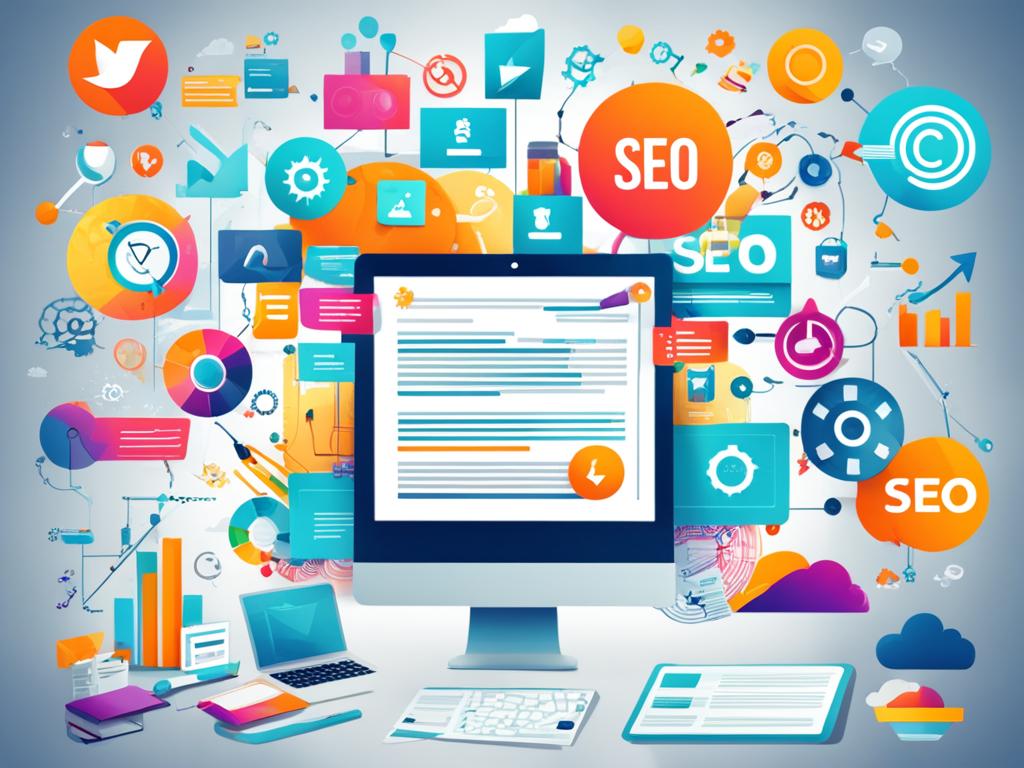
5. Structured Markup
Structured markup, such as schema.org markup, helps search engines understand the content and structure of your website better. By implementing structured data, you can enhance your website’s appearance in SERPs by displaying rich snippets and additional information.
6. Page URLs
Optimizing your page URLs is essential for both search engines and users. Use descriptive and keyword-rich URLs that accurately reflect the content on the page. This makes it easier for search engines to understand and rank your website’s pages.
7. Internal Linking
Internal linking is the practice of linking to other pages within your website. It helps search engines discover and index your pages more efficiently while also providing users with a better navigation experience. Use descriptive anchor text and relevant links to create a well-structured internal linking strategy.
8. Mobile Responsiveness
In today’s mobile-first era, having a website that is optimized for mobile devices is crucial. Mobile responsiveness ensures that your website adapts to different screen sizes and provides a seamless user experience across devices. Search engines prioritize mobile-friendly websites in their rankings.
9. Site Speed
Site speed is a critical ranking factor for search engines and directly impacts user experience. A fast-loading website not only improves your chances of higher rankings but also reduces bounce rates and improves conversion rates. Optimize your website’s code, compress images, and leverage caching techniques to improve site speed.
By optimizing these on-page SEO elements, you can improve your website’s rankings, visibility, and overall performance in search engine results. It’s essential to focus on these elements as part of your broader SEO strategy to attract organic traffic and achieve your online goals.
Content Elements
When it comes to on-page SEO, content elements play a crucial role in optimizing your website for higher rankings and visibility. Understanding how to effectively incorporate keywords into your content and align it with the buyer’s journey can significantly impact your search engine rankings. Let’s explore the key aspects of content elements in on-page SEO.
The Importance of Keyword Research
Keyword research is the foundation of on-page SEO. It involves identifying the most relevant and popular keywords that your target audience is using to search for information related to your products or services. By conducting comprehensive keyword research, you can discover the phrases that have the highest search volume and the least competition, enabling you to optimize your content effectively.
„Keyword research is like uncovering the secret language that your potential customers are using to find your offerings.“
Incorporating Keywords Naturally
Once you have identified your target keywords, it’s crucial to incorporate them naturally into your content. Avoid keyword stuffing, as it not only negatively impacts the readability of your content but also violates search engine guidelines. Instead, focus on creating high-quality, informative content that seamlessly integrates your target keywords in a way that provides value to your readers.
Relevance to the Buyer’s Journey
The buyer’s journey refers to the process that a potential customer goes through when making a purchase decision. It typically consists of three stages: awareness, consideration, and decision. To optimize your content for on-page SEO, it’s important to create different types of content that align with each stage of the buyer’s journey.
| Stage | Type of Content |
|---|---|
| Awareness | Informative blog posts, educational videos, eBooks |
| Consideration | Comparison guides, product reviews, case studies |
| Decision | Demo videos, free trials, customer testimonials |
Optimizing for Better Rankings and Visibility
By creating high-quality, relevant content that incorporates target keywords naturally and aligns with the buyer’s journey, you can optimize your website for better rankings and visibility. Search engines value websites that provide valuable and informative content to their users. By meeting these expectations, you increase your chances of ranking higher in search engine results pages and attracting more organic traffic to your website.
Remember, content elements are essential for on-page SEO success. By conducting thorough keyword research, incorporating keywords naturally, considering the buyer’s journey, and creating valuable content, you can significantly improve your website’s rankings and visibility in search engine results.
HTML Elements
In the world of on-page SEO, HTML elements play a vital role in optimizing your website for search engines. By optimizing key HTML elements, you can improve your website’s visibility and rankings in search engine results pages. In this section, I will discuss the importance of optimizing page titles, headers, meta descriptions, image alt-text, and structured markup – all of which are essential for effective on-page SEO.
Page Titles
One of the most crucial HTML elements for on-page SEO is the page title. The page title, also known as the <title> tag, appears in search engine results as the clickable headline for your webpage. It should accurately summarize the content and purpose of each individual page on your website. By crafting unique and keyword-rich page titles, you can improve your website’s relevancy and attract more organic traffic.
Headers
Headers, represented by the <h1>, <h2>, <h3>, and so on, are essential for structuring your webpage and organizing your content. These HTML elements not only make your content more scannable and readable for website visitors but also help search engines understand the hierarchy and relevance of your content. Incorporating relevant keywords in your headers can further enhance your on-page SEO.
Meta Descriptions
Meta descriptions, indicated by the <meta name=“description“ content=“…“> tag, provide a concise summary of your webpage’s content. Although meta descriptions do not directly impact search engine rankings, they play a crucial role in attracting clicks from search engine users. By crafting compelling meta descriptions that include relevant keywords, you can improve the click-through rate to your webpage and enhance its visibility in search engine results.
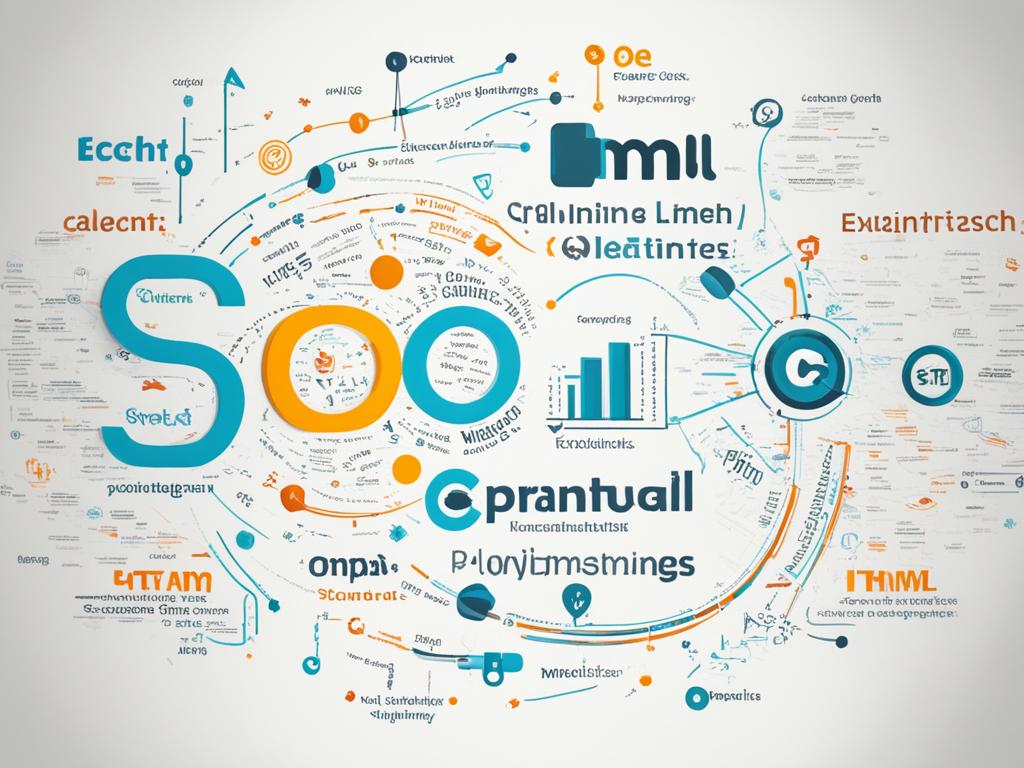
Image Alt-Text
Image alt-text, indicated by the <img src=“…“ alt=“…“> tag, is used to describe the content of an image to search engines and visually impaired users. By optimizing the alt-text of your images with relevant keywords, you can improve your website’s overall SEO. Additionally, descriptive alt-text helps search engines index your images appropriately, making them more likely to appear in image search results.
Structured Markup
Structured markup, often referred to as schema markup, is a standardized format used to provide additional context and information about your webpage’s content to search engines. By implementing structured markup using Schema.org vocabulary, you can enhance your website’s appearance in search engine results pages. Structured markup enables search engines to display rich snippets, such as star ratings, reviews, and product information, which can significantly improve the visibility and click-through rate of your webpages.
| HTML Element | Importance | Optimization Tips |
|---|---|---|
| Page Titles | High | – Include relevant keywords |
| Headers | Medium | – Use keyword-rich headers – Use hierarchical structure (h1, h2, h3, etc.) |
| Meta Descriptions | Medium | – Craft compelling, concise descriptions – Include relevant keywords |
| Image Alt-Text | Low | – Use descriptive alt-text – Include relevant keywords |
| Structured Markup | Medium | – Implement schema markup – Use appropriate Schema.org vocabulary |
Site Architecture Elements
Optimizing site architecture elements is crucial for effective on-page SEO. By focusing on key elements such as page URLs, internal linking, mobile responsiveness, and site speed, you can enhance your website’s visibility and user experience.
Page URLs
Page URLs play a significant role in on-page SEO. By optimizing your URLs to be concise, descriptive, and keyword-rich, search engines can easily understand the content and relevance of your webpages.
Internal Linking
Internal linking refers to the practice of connecting different pages within your website through hyperlinks. This helps search engines crawl and index your site effectively, improving overall visibility and making it easier for users to navigate between related content.
Mobile Responsiveness
In today’s mobile-dominated era, having a mobile-responsive website is vital. Mobile responsiveness ensures that your site adapts and performs well on various devices, including smartphones and tablets. By providing a seamless mobile experience, you enhance user satisfaction and improve your chances of higher search rankings.
Site Speed
Site speed is a critical factor that affects both user experience and search engine rankings. Optimizing your website’s loading time and overall performance can significantly enhance user satisfaction, reduce bounce rates, and improve your site’s visibility in search results.
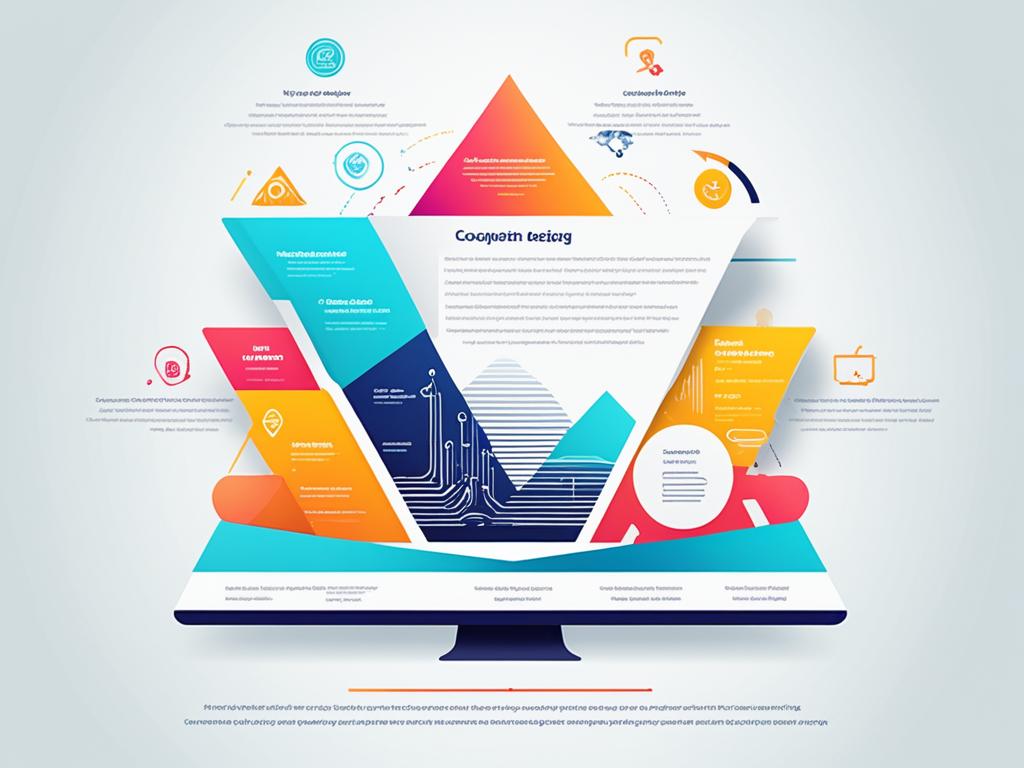
By prioritizing site architecture elements and following on-page SEO best practices, you can create a well-structured and optimized website that not only ranks higher in search engine results but also provides a seamless experience for your visitors.
On-Page SEO Checklist
Optimizing your webpages with on-page SEO techniques is essential for improving your website’s visibility and search engine rankings. To ensure that you cover all the crucial on-page SEO elements, use this checklist:
Keyword Placement
- Include relevant keywords naturally in your content, headings, and meta tags.
- Avoid keyword stuffing and maintain a good keyword density.
- Place keywords strategically in the URL structure.
Page Titles
- Create unique and descriptive page titles that accurately represent the content.
- Include relevant keywords in the page title.
Headings
- Use headings (H1, H2, H3, etc.) to structure your content.
- Include keywords in headings to provide semantic relevance.
Body Copy
- Create high-quality and engaging content that meets the needs of your target audience.
- Include relevant keywords naturally throughout the body copy.
- Ensure proper formatting with paragraphs, bullet points, and subheadings.
Images
- Optimize images by compressing them for faster loading times.
- Add descriptive alt-text to images, including relevant keywords.
- Ensure images are properly sized and have the correct aspect ratio.
Meta Descriptions
- Create unique and compelling meta descriptions for each webpage.
- Include relevant keywords to improve click-through rates.
- Keep meta descriptions within the recommended character limit.
Internal Linking
- Link to relevant pages within your website to improve navigation and user experience.
- Use descriptive anchor text with relevant keywords.
- Avoid excessive internal linking that may seem spammy.
External Linking
- Link to authoritative and relevant external sources to provide additional value to your readers.
- Ensure the external links open in new tabs or windows.
By following this comprehensive on-page SEO checklist, you can optimize your webpages effectively and improve your website’s visibility, rankings, and organic traffic.
Implementing these on-page SEO techniques will help you achieve better search engine rankings and attract more organic traffic to your website. Stay tuned for the next section where we explore advanced on-page SEO tactics.
Learn More About On-Page SEO
If you want to dive deeper into on-page SEO, there are plenty of resources available that can help you expand your knowledge and improve your website’s rankings and visibility. Whether you’re a beginner looking for comprehensive guides or an experienced SEO professional seeking advanced techniques, the following resources can provide further insights:
On-Page SEO Guides and Tutorials:
- The Ultimate On-Page SEO Guide: Best Practices and Strategies
- On-Page SEO Tutorial for Beginners: Step-by-Step Implementation
- Advanced On-Page SEO Techniques: Tactics for Dominating Search Rankings
Advanced On-Page SEO Techniques:
„Implementing advanced on-page SEO techniques can give your website a competitive edge in search engine rankings. By leveraging advanced tactics, such as optimizing structured markup, improving site speed, and enhancing internal linking, you can further boost your website’s visibility and organic traffic.“
By leveraging these on-page SEO resources, you can learn valuable strategies and tactics to enhance your website’s performance in search engine results pages. Remember to apply the knowledge gained from these guides and tutorials to continually refine your on-page SEO practices and achieve higher rankings.
Continue your journey to on-page SEO mastery by exploring these resources today!
Conclusion
After exploring the world of on-page SEO techniques, it is clear that they play a crucial role in improving your website’s rankings and visibility on search engine results pages. By optimizing various on-page elements such as content, HTML, and site architecture, you can ensure that your website is easily crawled and indexed by search engines.
Implementing on-page SEO best practices not only helps search engines understand your website better but also provides value to your users. By creating high-quality, relevant content, using appropriate keywords, and optimizing HTML elements, you can enhance the user experience and increase organic traffic to your website.
On-page SEO techniques are essential for establishing a strong online presence, gaining a competitive edge, and driving targeted organic traffic. By following the guidelines outlined in this article, you can optimize your website effectively and improve your chances of ranking higher on search engine results pages.
FAQ
What is on-page SEO?
On-page SEO, also known as on-site SEO, refers to the process of optimizing the various front-end and back-end components of your website to improve its visibility and rankings on search engine results pages.
Why is on-page SEO important?
On-page SEO is important because it allows search engines to understand your website and how it provides value to visitors and customers. By optimizing your website according to on-page SEO best practices, you are making it easier for search engines to crawl and index your pages, which improves your website’s visibility and ensures it is optimized for both search engines and human readers.
What are the elements of on-page SEO?
On-page SEO consists of various elements that need to be optimized to improve your website’s rankings. These elements include keyword research, visual content optimization, page titles, headers, meta descriptions, image alt-text, structured markup, page URLs, internal linking, mobile responsiveness, and site speed.
How do content elements relate to on-page SEO?
Content elements play a crucial role in on-page SEO. By creating high-quality, relevant content and using keywords effectively, you can optimize your website for better rankings and visibility. Additionally, understanding the buyer’s journey and creating different types of content for each stage can further enhance your on-page SEO efforts.
What is the significance of HTML elements in on-page SEO?
HTML elements, such as page titles, headers, meta descriptions, image alt-text, and structured markup, provide valuable information to search engines and help improve the visibility and rankings of your webpages. Optimizing these elements according to on-page SEO best practices is crucial for enhancing your website’s performance in search engine results pages.
How do site architecture elements impact on-page SEO?
Site architecture elements, including page URLs, internal linking, mobile responsiveness, and site speed, contribute to how search engines crawl and index your webpages, as well as how users navigate and interact with your website. By optimizing your site architecture according to on-page SEO best practices, you can improve your website’s rankings and user experience.
Is there an on-page SEO checklist I can follow?
Yes, there is an on-page SEO checklist that can guide you in optimizing your webpages. The checklist includes keyword placement, page titles, headings, body copy, images, meta descriptions, alt-text, internal linking, and external linking. By following this checklist, you can ensure that all important on-page SEO elements are optimized effectively.
Where can I learn more about on-page SEO?
If you want to dive deeper into on-page SEO, there are further resources available for learning more about this topic. You can find on-page SEO guides, tutorials, and advanced techniques that can help you improve your website’s rankings and visibility.
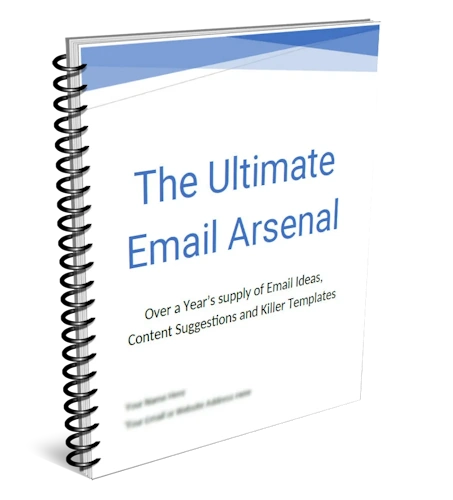
The Ulitmate Email Arsenal
„Banish Email Writer’s Block: Fuel Your Success With A Year’s Supply Of Email Subject Ideas & Conversion Driven Templates!“
- Over 52 Genius Email Subject Ideas & Content, one for every week of the year, paired seamlessly with over 52 high-converting email templates…
- Never be Stuck for Ideas Again: 40+ page guide, packed with over 8000 words of actionable insights, strategies, and insider tips to save you time…
- Get Ahead of Your Competitors: Unleash consistent engagement and keep your audience hooked, week after week…

